Vivonio Furniture Group Bundle
How did Vivonio Furniture Group rise to become a European furniture leader?
Founded in Munich, Germany, in 2012, Vivonio Furniture Group emerged with a bold vision: to reshape the European furniture industry. This strategic consolidation aimed to capitalize on market fragmentation and drive international growth. This article dives into the Vivonio Furniture Group SWOT Analysis, exploring its impressive journey and key milestones.
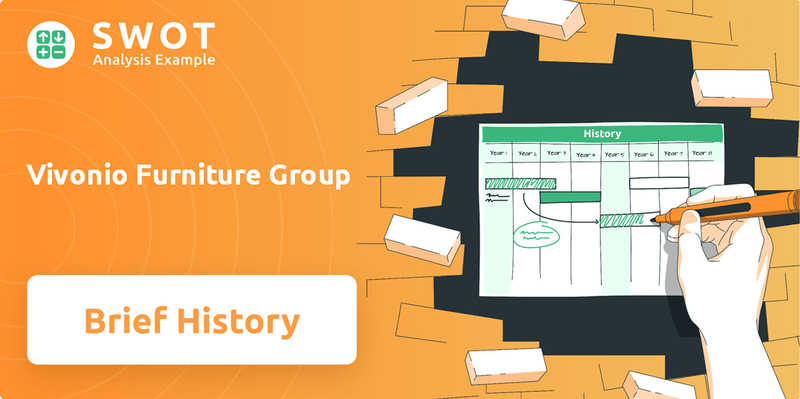
From its early acquisitions of Maja Möbel and Möbelwerk Staud, Vivonio's history reveals a calculated expansion strategy. This brief history of Vivonio Furniture Group will cover its evolution from a startup to a major player in the furniture industry. Learn about its acquisitions, manufacturing locations, and the brands that make up this influential European furniture company.
What is the Vivonio Furniture Group Founding Story?
The story of the Vivonio Furniture Group began on May 22, 2012, in Frankfurt am Main, Germany. The company's corporate headquarters later moved to Munich in February 2013. This marked the start of a significant player in the furniture industry, bringing together several established manufacturers.
The formation of Vivonio Furniture Group was a strategic move to consolidate and expand within the European furniture market. This consolidation was supported by Equistone Partners Europe, who became the majority shareholder, alongside investment funds advised by Orlando Management AG and the Vivonio management team.
The initial goal was to leverage synergies and drive international growth. This approach was designed to address the fragmented nature of the European furniture market. The founders aimed to build a strong foundation for further acquisitions and organic growth.
The Vivonio Furniture Group was created through the merger of key furniture manufacturers.
- The merger included Maja Möbel and Möbelwerk Staud.
- Equistone Partners Europe was the majority shareholder.
- Orlando Management AG and the Vivonio management team held minority stakes.
- The initial combined revenue of the founding companies was approximately EUR 200 million.
The founding group consisted of MAJA Möbel-Werke, known for ready-to-assemble furniture, Martin Staud, specializing in bedroom furniture, and SCIAE, a French manufacturer of bedroom and living room furniture. These companies had significant market presence before joining forces.
Tobias Fuhrmann and Niels Ackermann were key figures in leading the newly formed group as CEO and CFO, respectively. Their leadership was crucial in integrating the companies and setting the direction for future growth. This consolidation was aimed at creating a robust platform for further acquisitions and organic growth.
Vivonio Furniture Group SWOT Analysis
- Complete SWOT Breakdown
- Fully Customizable
- Editable in Excel & Word
- Professional Formatting
- Investor-Ready Format
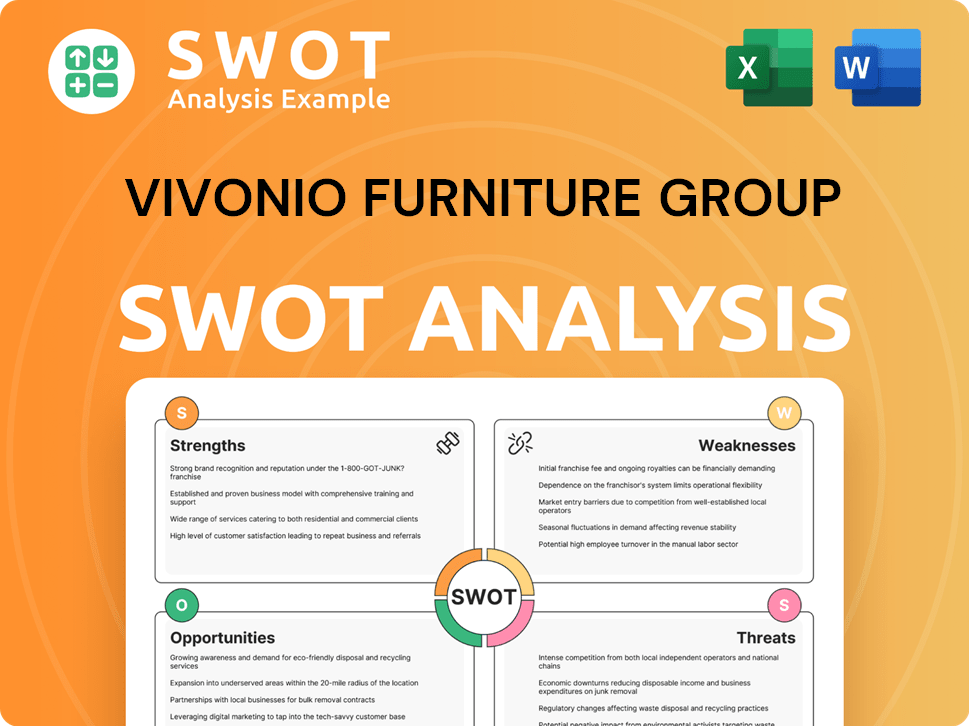
What Drove the Early Growth of Vivonio Furniture Group?
The early growth phase of the Vivonio Furniture Group focused on integrating initial acquisitions while expanding its product range and geographical reach. The strategy involved maintaining the independent market presence of its subsidiaries. This approach allowed for collaboration in purchasing and international expansion, aiming to leverage synergies. This period was marked by significant investments in production facilities and strategic acquisitions to strengthen its market position.
Between 2012 and 2013, MAJA, a subsidiary, invested over 60 million euros in a new lightweight furniture factory in Wittichenau. This investment more than doubled its production and warehouse area to over 85,000 square meters. The facility was crucial for producing lightweight building panels, primarily for IKEA's Malm, Alex, and Kallax series. This expansion created over 200 jobs, showcasing the company's commitment to growth and production capacity.
In 2016, Vivonio Furniture Group acquired Leuwico, an office furniture manufacturer, to strengthen its premium office furniture segment. The integration of fm Büromöbel in 2017 further solidified its office furniture offerings. Acquisitions such as Noteborn in March 2017 and KA Interiør in June 2018 expanded Vivonio's presence in made-to-measure products. These strategic moves helped the company expand its Competitors Landscape of Vivonio Furniture Group, particularly in the Benelux countries and Scandinavia.
By 2019, Vivonio Furniture Group comprised seven companies and eight production sites. The group employed approximately 1,800 employees, generating a group turnover of 400 million euros. The company focused on supplying major furniture chain stores in Germany and Europe, as well as specialist office furniture traders. This demonstrates the company's significant growth and market presence during this period.
Despite market challenges, the company demonstrated dynamic growth and stability. This was partly due to structural growth trends in the furniture market, including increased home working. The company's ability to adapt and expand its product offerings, along with strategic acquisitions, contributed to its success. This also reflects the broader trends in the European furniture industry.
Vivonio Furniture Group PESTLE Analysis
- Covers All 6 PESTLE Categories
- No Research Needed – Save Hours of Work
- Built by Experts, Trusted by Consultants
- Instant Download, Ready to Use
- 100% Editable, Fully Customizable
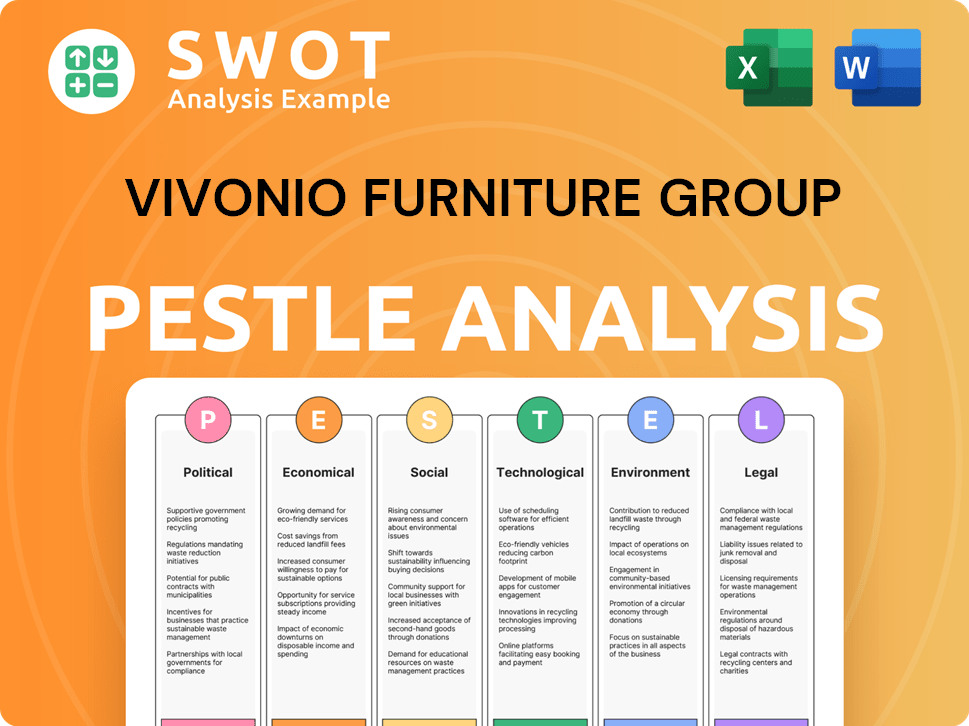
What are the key Milestones in Vivonio Furniture Group history?
The Vivonio Furniture Group has a rich history marked by significant milestones in the furniture industry. The company's journey includes strategic investments, acquisitions, and expansions, all contributing to its evolution within the European furniture market.
| Year | Milestone |
|---|---|
| 2012-2013 | Substantial investment of over 60 million euros into MAJA's Wittichenau factory, significantly expanding production capabilities. |
| 2016 | Acquisition of Leuwico, expanding the group's portfolio. |
| 2017 | Acquisitions of Noteborn and fm Büromöbel, further diversifying the product range. |
| 2018 | Acquisition of KA Interiør, solidifying market position. |
| 2019 | Reached a total of seven subsidiaries, 1,800 employees, and a turnover of 400 million euros. |
| 2023 | Closure of both Maja furniture factories. |
| 2024 | Preliminary insolvency proceedings opened for Leuwico and Staud. |
Vivonio's innovations centered on high-performance manufacturing, particularly in lightweight furniture production. The group's investment in the MAJA factory allowed for the production of high-volume items, such as the Malm, Alex, and Kallax series, showcasing its ability to innovate in manufacturing processes.
The investment in the Wittichenau factory enabled the production of popular furniture series.
Focus on manufacturing lightweight furniture to meet market demands and reduce costs.
Acquisitions expanded the product portfolio to include office, living, and made-to-measure furniture.
Diversification across different furniture segments, including office and living spaces.
Implementation of advanced manufacturing techniques to enhance efficiency and quality.
Optimizing supply chain processes to improve production and delivery times.
Despite its successes, Vivonio Furniture Group faced several challenges. The MAJA crisis, particularly regarding the new lightweight building panel manufacturing facility, presented significant operational and financial strain. The European furniture market has experienced downturns, with online furniture sales decreasing by 13.3% in the second quarter of 2023, which has impacted the company.
The new lightweight building panel manufacturing facility faced operational and financial challenges.
Production volumes lagged behind targets, leading to financial strain and broken banking covenants.
The European furniture market experienced downturns, affecting sales and profitability.
Online furniture sales decreased, impacting revenue streams and market share.
The closure of Maja furniture factories by the end of 2023, indicating significant challenges.
Preliminary insolvency proceedings for Leuwico and Staud in November 2024 further highlight the challenges.
Vivonio Furniture Group Business Model Canvas
- Complete 9-Block Business Model Canvas
- Effortlessly Communicate Your Business Strategy
- Investor-Ready BMC Format
- 100% Editable and Customizable
- Clear and Structured Layout
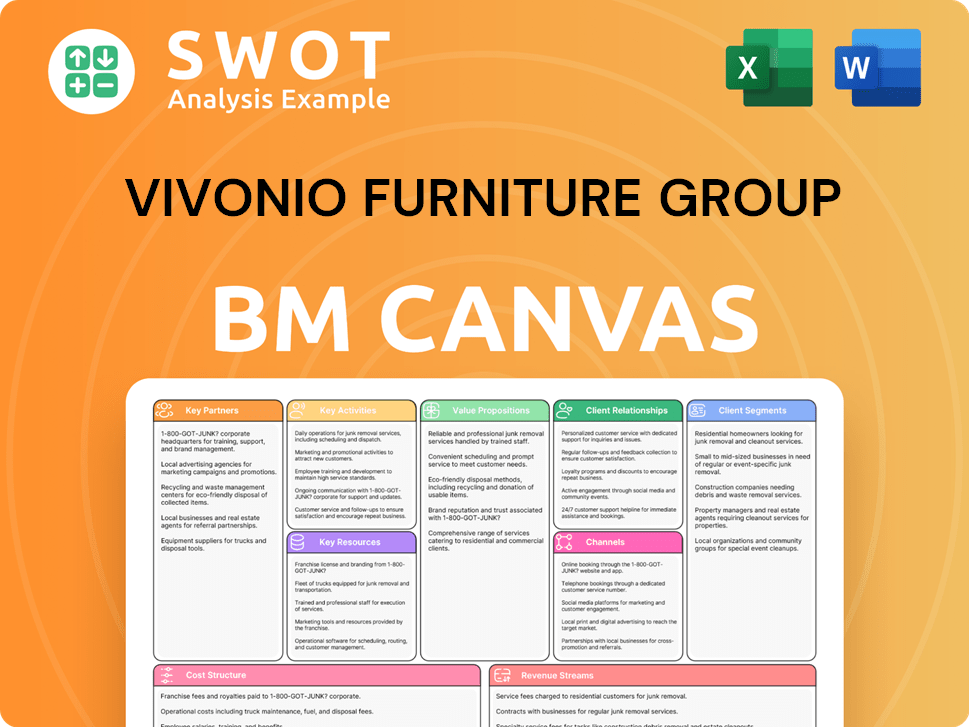
What is the Timeline of Key Events for Vivonio Furniture Group?
The Vivonio Furniture Group has a dynamic history, marked by strategic growth and recent challenges. Founded in 2012, the furniture company quickly expanded through acquisitions and strategic investments, reaching a peak turnover in 2019. However, recent developments, including the closure of factories and insolvency proceedings for some subsidiaries, indicate a period of restructuring.
| Year | Key Event |
|---|---|
| 2012 | Vivonio Furniture Group founded in Frankfurt am Main through the merger of Maja Möbel and Möbelwerk Staud. |
| 2013 | Corporate office relocated to Munich, Germany, and over 60 million euros invested in a new lightweight furniture factory. |
| 2015 | MAJA's Wittichenau plant reaches targeted production capacity. |
| 2016 | Acquisition of office furniture manufacturer Leuwico. |
| 2017 | Acquisition of Noteborn and fm Büromöbel. |
| 2018 | Acquisition of KA Interiør. |
| 2019 | Group turnover reaches 400 million euros with approximately 1,800 employees and seven subsidiaries. |
| 2022 | Successful refinancing of existing senior credit facilities and shareholder loans. |
| 2023 | Announcement of the closure of both Maja furniture factories by year-end. |
| 2024 (May) | Kristian Bonde appointed CEO of KA Interiør, focusing on international growth. |
| 2024 (November) | Preliminary insolvency proceedings opened for subsidiaries Leuwico and Staud. |
The European furniture industry presents growth opportunities, particularly in modular and flat-pack furniture. The market is expected to reach USD 25.28 billion in 2025, growing to USD 37.34 billion by 2032. Demand is driven by trends like increased home working and a focus on home comfort.
Insolvency proceedings for Leuwico and Staud signal significant operational challenges. The group must focus on integrating its remaining strong companies. The group will need to adapt to evolving market demands for intelligent, sustainable, and user-configurable furniture solutions.
The Vivonio Furniture Group aims to leverage synergies and expand internationally. KA Interiør, under new leadership, targets a profit of 5-10 million DKK and a revenue increase of 15-20% in 2024. The group will likely adapt to market changes.
The modular and flat-pack furniture market is estimated at USD 18.58 billion in 2024 and is set to expand to USD 29.66 billion by 2033, growing at a CAGR of 6.91%. Innovations in smart features and eco-certified materials are also shaping the industry.
Vivonio Furniture Group Porter's Five Forces Analysis
- Covers All 5 Competitive Forces in Detail
- Structured for Consultants, Students, and Founders
- 100% Editable in Microsoft Word & Excel
- Instant Digital Download – Use Immediately
- Compatible with Mac & PC – Fully Unlocked
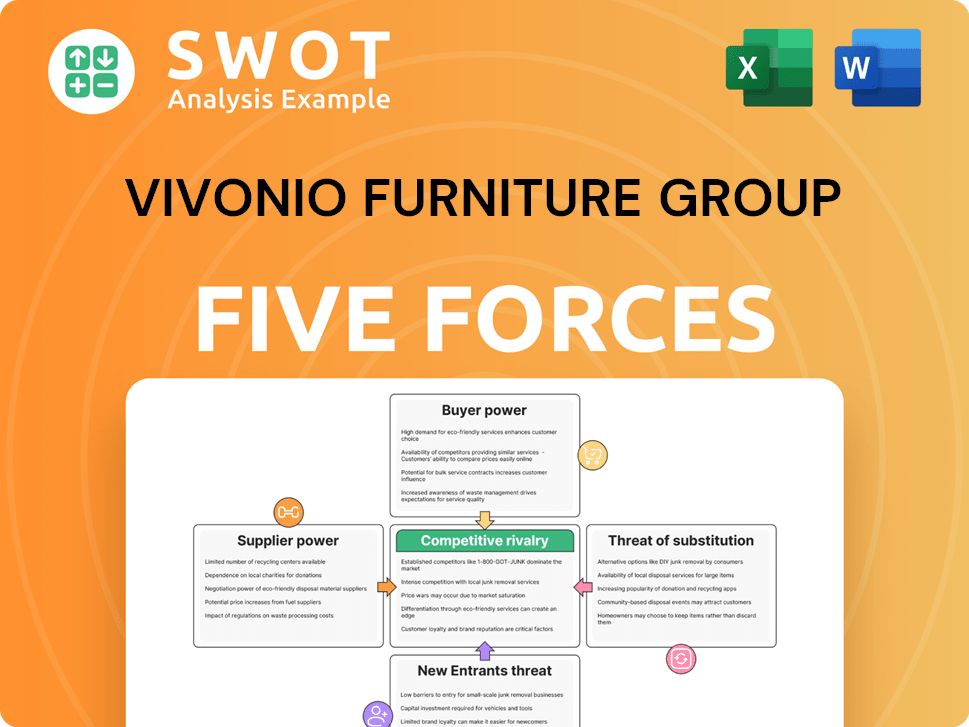
Related Blogs
- What is Competitive Landscape of Vivonio Furniture Group Company?
- What is Growth Strategy and Future Prospects of Vivonio Furniture Group Company?
- How Does Vivonio Furniture Group Company Work?
- What is Sales and Marketing Strategy of Vivonio Furniture Group Company?
- What is Brief History of Vivonio Furniture Group Company?
- Who Owns Vivonio Furniture Group Company?
- What is Customer Demographics and Target Market of Vivonio Furniture Group Company?
Disclaimer
All information, articles, and product details provided on this website are for general informational and educational purposes only. We do not claim any ownership over, nor do we intend to infringe upon, any trademarks, copyrights, logos, brand names, or other intellectual property mentioned or depicted on this site. Such intellectual property remains the property of its respective owners, and any references here are made solely for identification or informational purposes, without implying any affiliation, endorsement, or partnership.
We make no representations or warranties, express or implied, regarding the accuracy, completeness, or suitability of any content or products presented. Nothing on this website should be construed as legal, tax, investment, financial, medical, or other professional advice. In addition, no part of this site—including articles or product references—constitutes a solicitation, recommendation, endorsement, advertisement, or offer to buy or sell any securities, franchises, or other financial instruments, particularly in jurisdictions where such activity would be unlawful.
All content is of a general nature and may not address the specific circumstances of any individual or entity. It is not a substitute for professional advice or services. Any actions you take based on the information provided here are strictly at your own risk. You accept full responsibility for any decisions or outcomes arising from your use of this website and agree to release us from any liability in connection with your use of, or reliance upon, the content or products found herein.